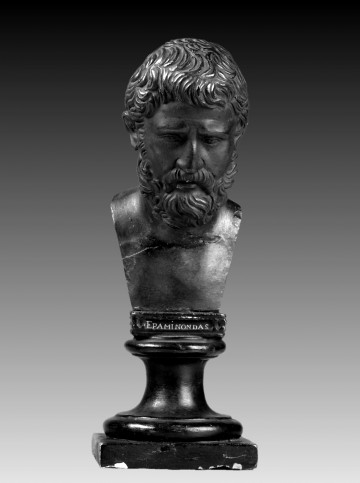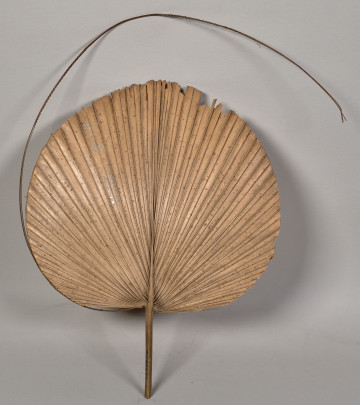
Bust of Epaminondas
18th century
Castle Museum in Łańcut
Part of the collection: Weapons, music instruments, varia
The bronze cannon barrel from 1740 described below comes from the Potocki collection and is marked with the inventory no. S 608 MŁ. Cannons are projectile firearms that use the energy of burning gunpowder. Its history dates back to the thirteenth century and distant China. In Europe, this type of weapon appeared at the beginning of the 14th century, for the first time at the Battle of Crécy on August 26, 1346. In the collection of the Museum – Castle in Łańcut, all cannon barrels are exhibited without carriages - an indispensable part of each cannon that allows them to be moved, as well as positioned vertically and horizontally. Each barrel gives the bullet (bullet) a forward motion, and in the case of rifled barrels, additionally a rotational movement, improving accuracy and effectiveness. The barrel exhibited in the Museum-Castle in Łańcut belongs to the group of unrifled barrels, firing spherical bullets (projectiles) made of stone or cast iron. It is made of bronze - an alloy of copper with tin, zinc and lead. The barrel is 2.45 m long and has a calibre of 9 cm. It has blocked ignition, rich decoration and ears in the shape of dolphins, arched and covered with scales. Between the zeal and the ears there is the coat of arms of Pilawa under a crown with five stylized feathers surrounded by heraldic charges. Under the coat of arms there is the Order of the White Eagle. The lowest inscription is IOSEPHUS· APOTOK; INSTANISLAVOV· BARAZ· BEARDS· NIEMIERÓW· PIPE/PAL· CRL· TER· KIIOVIR· SUPR· EXERCIT· REC· POL:DUX· WARSAW· SNIAT· LEZAYS· CAPITA· ADPROFLGATIONEM· HOSTIUM· FORTALITIS· STANISLAO· POLIENSIS· DEFENSIONEM· FIERI· IVSST· MDCCXL
Between the ears and the muzzle of the barrel there is a bas-relief presenting St. Andrew, and below there is a plaque with the inscription GLORIA META MIEHI. Even lower there is an oval box with an ornament and the inscription S ANDREEAS
The entire barrel, despite the signs of use, is in very good condition. It can be seen in the Great Vestibule of the Łańcut Castle, supported by two wooden pedestals in heraldic colours decorated with the Pilawa coat of arms.
Our barrel comes from Stanisławów (now Ivano-Frankivsk). Stanisławów was founded by the castellan of Cracow and field hetman of Cracow, Andrzej Potocki, on 7 May 1662 in the confluence of the Bystrzyca River (Nadworniańska and Sołotwińska) near the village of Zabłatowa. On August 14, 1663, in Lviv, King Jan Kazimierz approved the location of the city under the Magdeburg Law. Stanisławów, together with nearby Halicz, especially after the fall of Kamień Podolski, was an important fortress in the system of defence of the south-eastern border of the Republic of Poland. The name of the city should be associated with the name of the first-born son of Andrzej Potocki, a hero of the Relief of Vienna, who died during the charge of the Crown Hussar banner of castellan A. Potocki at Vienna on September 12, 1683, or the name of his father, Stanisław "Rewera" Potocki, Grand Hetman of the Crown, provincial governor of Kyiv, Cracow, Podolia and others, participant of at least 46 battles, in the war with the Swedes (the Deluge), Cossack wars, Khmelnytsky Uprising and the Battle of Chudnov.
Przemysław Kucia
Object type
militaria
Material
bronze
Creation time / dating
Owner
Muzeum - Zamek w Łańcucie
Identification number
Location / status

18th century
Castle Museum in Łańcut

XVII wiek
Castle Museum in Łańcut

20th century
Castle Museum in Łańcut
DISCOVER this TOPIC
Museum of King Jan III's Palace at Wilanów
DISCOVER this PATH
Educational path